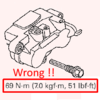I picked up a 2002 st1300 a few days ago.
It has a brake fault and came with a load of new parts.
In a nutshell, the rear brake is dragging, quite a bit but no seized on. I've been through the usual
Bleeding
Rebuild SMC
Bleeding
Tested the smc on the floor, it has minimal free play and activates the rear brake and releases OK.
Calliper strip and clean
Bleeding
Genuine and non genuine rear pads
Removing the tension spring (to test only)
Greasing all the relevant points
Undo the rear end and put back together.
Still, 2 days on I can't get the brake to release properly.
What I have noticed -
When Bleeding the rear most nipple of the rear calliper, fluid doesn't seem to flow as free, I assume this could be down to the PCV
When pushing the middle piston back, it returns no bother.
If I push either outer piston, it pushes out the opposing one, if I try doing them both together, I can't do it by hand.
if i push it back, using a tool, the wheel will turn freely until i apply the brake again
My feeling is that there is some sort of obstruction between the PCV (which bleeds freely) and the rear calliper connection.
Can someone keep me right?
Thank you
It has a brake fault and came with a load of new parts.
In a nutshell, the rear brake is dragging, quite a bit but no seized on. I've been through the usual
Bleeding
Rebuild SMC
Bleeding
Tested the smc on the floor, it has minimal free play and activates the rear brake and releases OK.
Calliper strip and clean
Bleeding
Genuine and non genuine rear pads
Removing the tension spring (to test only)
Greasing all the relevant points
Undo the rear end and put back together.
Still, 2 days on I can't get the brake to release properly.
What I have noticed -
When Bleeding the rear most nipple of the rear calliper, fluid doesn't seem to flow as free, I assume this could be down to the PCV
When pushing the middle piston back, it returns no bother.
If I push either outer piston, it pushes out the opposing one, if I try doing them both together, I can't do it by hand.
if i push it back, using a tool, the wheel will turn freely until i apply the brake again
My feeling is that there is some sort of obstruction between the PCV (which bleeds freely) and the rear calliper connection.
Can someone keep me right?
Thank you




